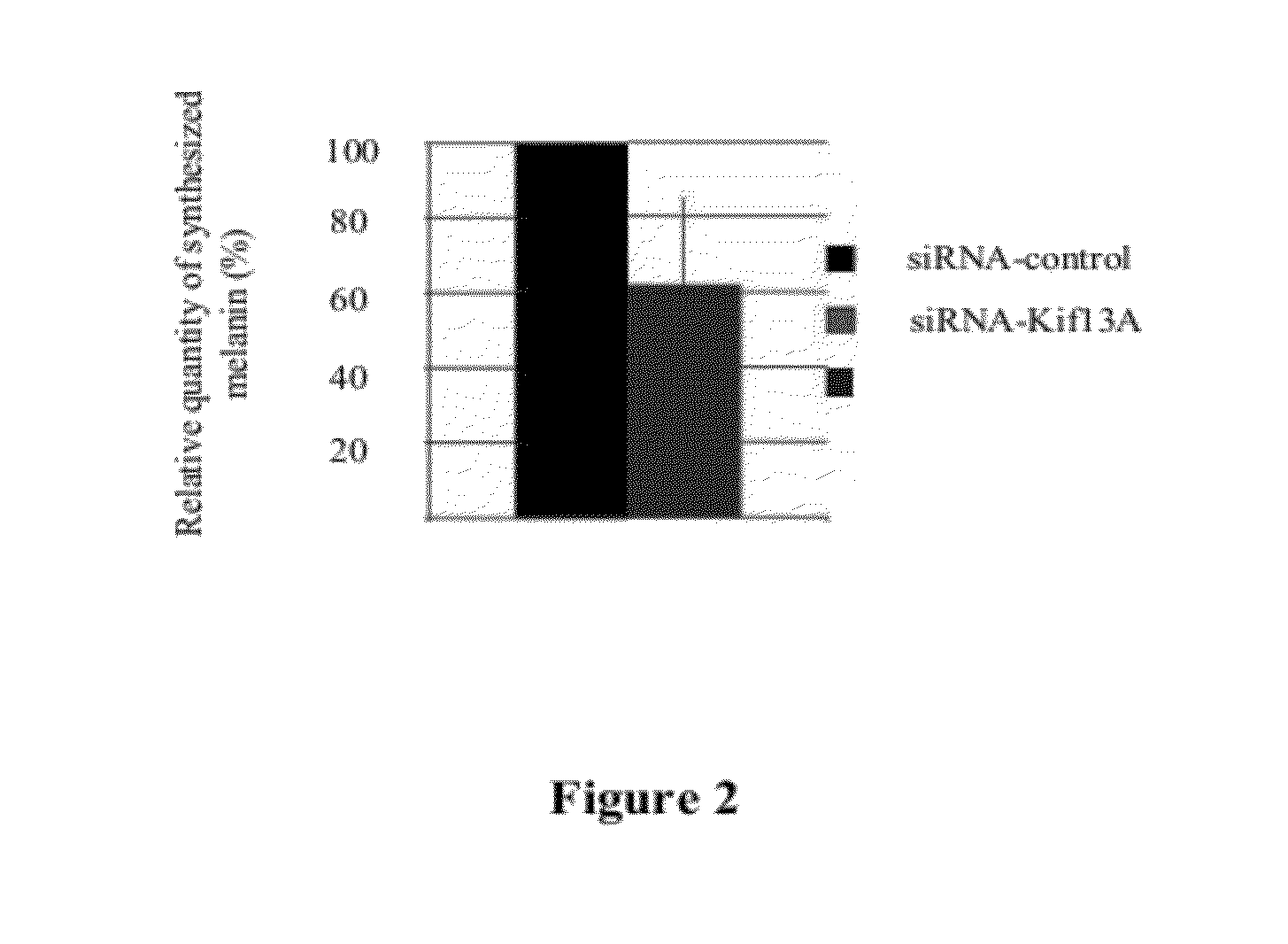Use of kif13a and ap-1 inhibitors for inhibiting melanogenesis
a technology of kif13a and ap-1 inhibitor, which is applied in the direction of peptide/protein ingredients, dna/rna fragmentation, unknown materials, etc., can solve problems such as pigmentation anomalies, and achieve the effect of stable in suitable formulations
- Summary
- Abstract
- Description
- Claims
- Application Information
AI Technical Summary
Benefits of technology
Problems solved by technology
Method used
Image
Examples
example 1
[0134]Western-blot experiments on cellular lysates of melanocytes transfected with siRNA-AP-1 (μ1A), siRNA-Kif13A and siRNA-AP-3 (β3A) made it possible to show that the expression of Kif13A is not disrupted by inactivation of AP-1 or AP-3 (FIG. 1A). On the other hand, in melanocytes transfected with siRNA-Kif13A, the expression of Kif13A was completely suppressed (FIGS. 1A and 1C) whereas the expression of the μ1A sub-unit of AP-1 was not disrupted. These results thus show the effectiveness and the specificity of siRNA to inactivate this protein in melanocytes.
[0135]Moreover, immunoprecipitation experiments carried out on melanocytes made it possible to show that the Kif13A protein co-precipitates with the γ-adaptin AP-1 sub-unit and thus that the interaction between Kif13A and AP-1 observed previously in non-melanocyte cell lines (Nakagawa et al., 2000) also exists in melanocyte cell lines (FIG. 1B).
[0136]The relative quantity of melanin in melanocytes transfected with siRNA-Kif13A...
example 2
[0148]The western blot experiments on transfected melanocytes (FIG. 4) made it possible to show that the expression of the μ1A sub-unit of AP-1 is strongly decreased in melanocytes transfected with siRNA-μ1A compared to those transfected with siRNA-control. This drop in expression also involved a decrease in the expression of another sub-unit of AP-1, γ-adaptin, with the consequence of destabilizing the AP-1 adaptor complex. These results thus confirm that the inactivation of only one sub-unit of AP-1 is enough to completely destabilize this complex. Moreover, it was observed in a surprising manner that in the cells transfected with siRNA-μ1A and thus deficient in AP-1, the expression of tyrosinase, a key enzyme of melanogenesis, was strongly decreased, as was the expression of Tyrp-1 enzyme although less strongly.
[0149]These results thus show that inactivation of only one sub-unit of AP-1 is enough to destabilize and inactivate the adaptor complex but also disturbs expression of th...
PUM
| Property | Measurement | Unit |
|---|---|---|
| pH | aaaaa | aaaaa |
| temperature | aaaaa | aaaaa |
| temperature | aaaaa | aaaaa |
Abstract
Description
Claims
Application Information
 Login to View More
Login to View More - R&D
- Intellectual Property
- Life Sciences
- Materials
- Tech Scout
- Unparalleled Data Quality
- Higher Quality Content
- 60% Fewer Hallucinations
Browse by: Latest US Patents, China's latest patents, Technical Efficacy Thesaurus, Application Domain, Technology Topic, Popular Technical Reports.
© 2025 PatSnap. All rights reserved.Legal|Privacy policy|Modern Slavery Act Transparency Statement|Sitemap|About US| Contact US: help@patsnap.com



